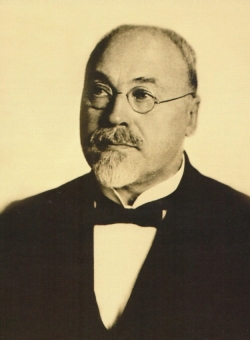Gustavs Zemgals was born on 12 August 1871 in Džūkste small rural district. He studied at the Nickolas Grammar School in Riga; he graduated from the Faculty of Law of Moscow University in 1899.
After the graduation, he worked in Riga as attorney at law. In 1901, he was elected as Chairman of Latvian workers and craftsmen association “Jonatans” in Riga. He also actively worked in the associations of Latvian craftsmen assistance society and the performing art society “Jaunais teātris” (New Theatre). In 1905, he was the editor in chief of the newspaper “Jaunā Dienas Lapa” (New Daily Page). He took part in the foundation of the Latvian Democratic Party.
From 1919 to 1927, he performed the duties of Riga City Mayor. From 1918 to 1919, he was Vice-President of the Peoples’ Council. On 18 November 1918, he chaired the Latvia independence declaration solemn act at the National Theatre. From 1921 to 1923, he was a Member of the Latvian Parliament (Saeima). From 10 June 1921 to 26 January 1923, he was the Minister of Defence. On 16 November 1926, G.Zemgals was awarded the Order of Three Stars, class III.
On 15 June 1921, the Cabinet of Latvian agricultural policy founder and Prime Minister Zigfrīds Anna Meierovics started its work. Zemgals had to perform the duties the Minister of Defence at the Cabinet until 23 January 1923. Afterwards Zemgals returned to the private life operating as notary in Riga, although not to the full extent. He was elected to the first Saeima Democratic Centre and to the non-party public official’s fraction, where he was a member of the party to replace Jānis Čakste, when he was elected as the President of Latvia.
President of Latvia Jānis Čakste died, who had been able to unite the various political deviations around him and there was not much statesmen of his kind at the political stage during a period of Marģers Skujenieks’ left government. Having examined various political figures, Minister for Foreign Affairs Fēlikss Cielēns at that time decided to put forward democratic Zemgals as the candidate. Zemgals gave the answer of consent only after several days of hesitation. On 8 April 1927, the Saeima elected Gustavs Zemgals as the President of Latvia after the recurrent voting with 73 against 23 votes.
Gustavs Zemgals became the President of Latvia at the age of 56. Not being a representative of the major political parties, he as the head of the State managed to unite the different groups and the minority interests as well. In his policy, Zemgals followed the traditions established by his predecessor, although not so convincing and subtle as Jānis Čakste. However, he coped well with the national representation obligations. Having grown in difficult conditions, Gustavs Zemgals was actually a hard-working, shy and simple in his life style, his open dislike of the protocol was well-known probably troubled with weak knowledge of French. He deemed the involvement of all public layers in the state democratic agencies and the enhancement of the national prestige as one of the most important duties of a president.
During a period of Gustavs Zemgals’ presidency, he paid the Latvian state visit to Sweden, which meant full recognition of the neighbouring state for Latvia and inclusion in the Northern European family of democratic nations at that time indirectly. On 28 May 1929, Gustavs Zemgals paid the state visit to Stockholm. The return visit of the Swedish King Gustav V to Latvia took place on 29 June 1929.
The term of powers of Zemgals as the President expired on 9 April 1930. He flatly refused to run for the high office once again. Within a period of his activities, he had never interfered with the legislative activities, neither proposed any bill, nor convened any meeting of the Cabinet and he sent back a bill to the Saeima for revision only once; moreover, not because of the content but rather for legal reasons.
Having left the post of the President of Latvia, Zemgals’ political activities continued at IV Saeima, where he was elected as the representative of the Democratic centre and the non-party public officials’ fraction. The parliamentarians elected Zemgals to be a member of the Foreign Affairs, Finance, Commerce, and Industry Committee. Gustavs Zemgals was invited to become the Minister of Finance on 11 December 1931, but he soon resigned by the reason of discrepancies on the budget and other financial issues with other members of the Cabinet and the parliamentary committee, continuing the activities as the rank and file MP. During the following two years, he reported for and on behalf of the committee for 17 times, covering the foreign policy issues mostly. Zemgals greatly contributed to the process of convergence of the Baltic nations, including the Scandinavian states. In 1933, he was elected as the President of Baltic Union. Throughout the life, he remained the convinced democrat; still he was in the opposition at the end of Ulmanis’ authoritarian regime period.
Gustavs Zemgals died at the age of 65 in still free Latvia on 6 January 1939 and was buried at Meža Cemetery.




